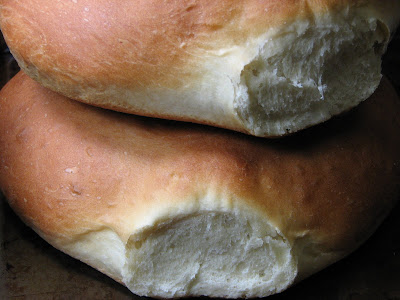 Procedure
Procedure1. Proof the yeast. Mix together the 1/2 cup warm water, 2 tsp yeast, 2 tsp sugar and 2 tbsp of flour in a small bowl and set aside for 10 minutes.
2. Warm milk, fat, sugar, and salt in the microwave for about 20 seconds-stir together and set aside. Don't let the mixture boil, you just want to heat it up a bit. Sift 5 cups of flour into a large bowl.
3. Once the milk mixture has cooled enough that you can comfortably stick a finger in it, mix it into the yeast.
4. Add wet ingredients to the flour. Mix with a wooden spoon until a dough forms. If sticky, add flour until you have a dough that you can knead.
5. Dust your counter with flour and knead the dough until smooth, about 5-8 minutes. If the dough becomes sticky as you knead just sprinkle with flour as required. You may have to add up to a cup of flour at this stage depending on the humidity of your kitchen.
6. Put in greased bowl, cover with a damp cloth and let rise until double in size. Punch down and knead for two or three minutes. Make into two large or six small round balls. Place on a greased pan-let rise again, bake at 400 F/205 C for 30-35 minutes until the tops brown and the bottom of a loaf, when tapped, sounds hollow.
 This is one of those breads that my mother never made but that always reminds me of home because of how many times I ate it on market day when we were in town. I hadn't thought about it until a couple weeks ago when I came across a treasure trove of Belizean recipes online. They were posted on recipehound.com in some ancient format by a Belizean lady named Erleen Godfrey. Thanks to her, I made creole bread from scratch for the first time this week and it turned out wonderfully, puffing up in the oven and browning to a beautiful rich tone. Thank you Ms. Erleen, wherever you may be:).
This is one of those breads that my mother never made but that always reminds me of home because of how many times I ate it on market day when we were in town. I hadn't thought about it until a couple weeks ago when I came across a treasure trove of Belizean recipes online. They were posted on recipehound.com in some ancient format by a Belizean lady named Erleen Godfrey. Thanks to her, I made creole bread from scratch for the first time this week and it turned out wonderfully, puffing up in the oven and browning to a beautiful rich tone. Thank you Ms. Erleen, wherever you may be:). Belizean Creole Bread
Belizean Creole Bread